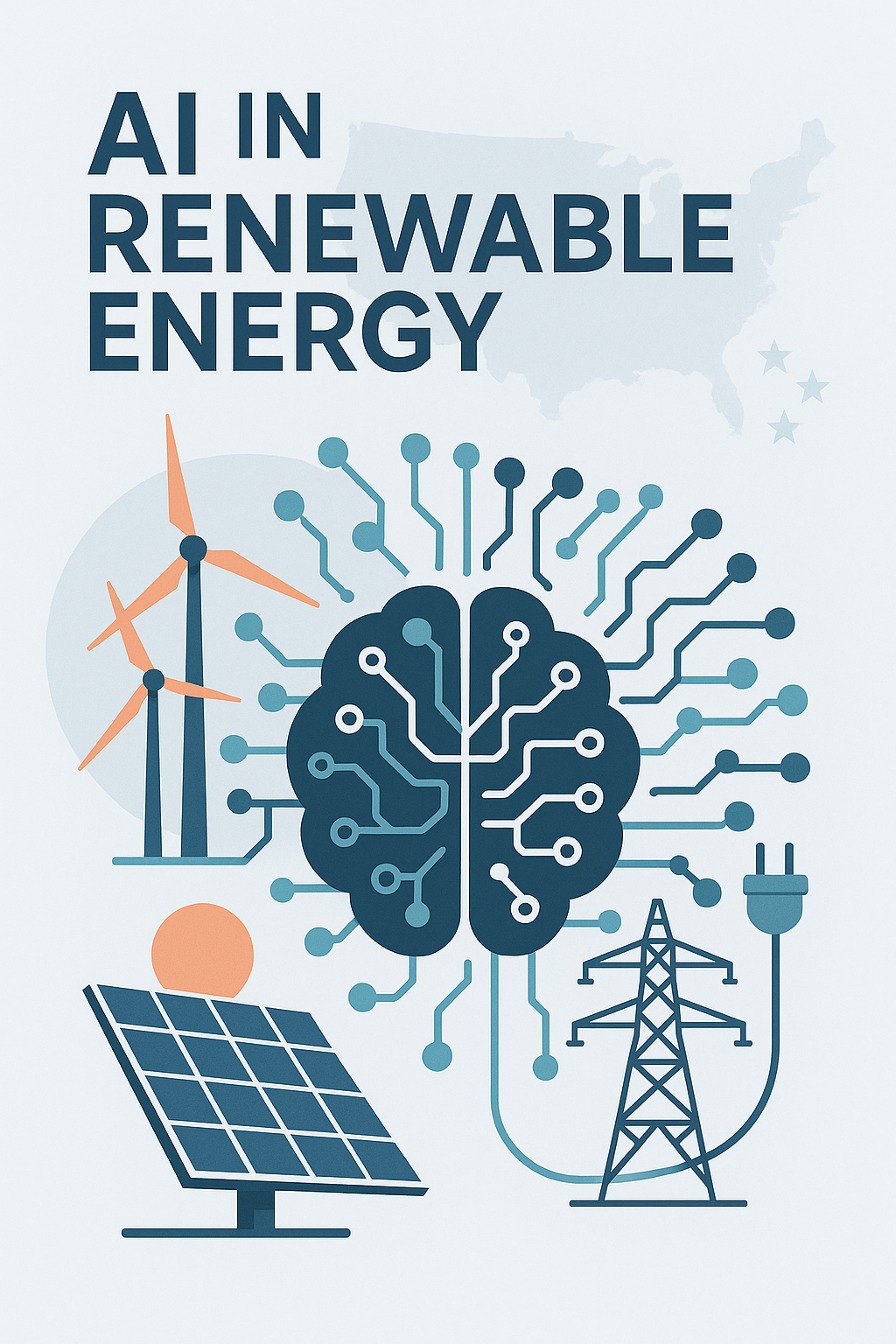
AI in Renewable Energy: Transforming the Future of Clean Power in 2025
The integration of artificial intelligence (AI) in renewable energy is revolutionizing how the United States generates, distributes, and consumes clean power. As we move into 2025, AI-driven solutions are optimizing everything from solar and wind energy production to grid management and predictive maintenance. This comprehensive guide explores the latest trends, benefits, and real-world applications of AI in renewable energy, tailored for U.S. businesses, policymakers, and eco-conscious consumers.
Understanding AI in Renewable Energy: What It Means for the U.S. Market
Artificial intelligence refers to computer systems that can perform tasks typically requiring human intelligence, such as learning, reasoning, and problem-solving. In the context of renewable energy, AI technologies are being deployed to:
- 📈 Forecast energy production and demand
- ⚡ Optimize grid operations
- 🏭 Enhance equipment maintenance
- 🌞 Maximize solar and wind efficiency
TIP: Embracing AI in renewable energy can lead to significant cost savings, increased reliability, and a faster transition to a sustainable energy future.
Top 10 Applications of AI in Renewable Energy (2025)
AI is reshaping the renewable energy sector in the U.S. Here are the top 10 applications making the biggest impact this year:
- Predictive Maintenance for Wind Turbines
- Solar Panel Performance Optimization
- Smart Grid Management
- Energy Demand Forecasting
- Battery Storage Optimization
- Automated Fault Detection
- Renewable Energy Trading Platforms
- Microgrid Control Systems
- Weather Prediction for Energy Planning
- Energy Efficiency in Buildings
Side-by-Side Comparison Table: AI Applications in Renewable Energy
| Rank | Application | Main Benefit | Typical Use Case |
|---|---|---|---|
| 1 | Predictive Maintenance (Wind) | Reduces downtime | Wind farms |
| 2 | Solar Panel Optimization | Increases output | Solar farms, rooftops |
| 3 | Smart Grid Management | Balances supply & demand | Utility companies |
| 4 | Energy Demand Forecasting | Improves planning | Grid operators |
| 5 | Battery Storage Optimization | Extends battery life | Storage facilities, homes |
| 6 | Automated Fault Detection | Minimizes outages | All renewable installations |
| 7 | Renewable Energy Trading Platforms | Maximizes profits | Energy markets |
| 8 | Microgrid Control Systems | Enhances resilience | Remote communities, campuses |
| 9 | Weather Prediction | Boosts forecasting accuracy | Solar/wind project developers |
| 10 | Energy Efficiency in Buildings | Cuts energy waste | Commercial & residential |
How AI Improves Solar and Wind Energy Production
AI-Driven Solar Power Optimization
AI algorithms analyze real-time data from solar panels to:
- 📊 Adjust panel angles for maximum sunlight
- 🛠️ Detect and predict equipment failures
- ☁️ Compensate for changing weather conditions
AI in Wind Energy: Smarter Turbines
Wind farms use AI to:
- 🌀 Predict wind patterns and adjust turbine blades
- 🔧 Schedule maintenance before breakdowns occur
- 📉 Reduce operational costs and increase uptime
TIP: By leveraging AI, U.S. solar and wind projects can achieve up to 20% higher efficiency compared to traditional methods.
AI-Powered Smart Grids: The Backbone of Renewable Energy Integration
Smart grids use AI to manage the complex flow of electricity from diverse renewable sources. Key benefits include:
- ⚡ Real-time balancing of supply and demand
- 🔄 Seamless integration of distributed energy resources (DERs)
- 🏠 Support for prosumers (consumers who also produce energy)
Example: AI in U.S. Smart Grid Operations
# Example: AI-based load forecasting for a smart grid
import numpy as np
from sklearn.ensemble import RandomForestRegressor
# Simulated historical load and weather data
X = np.array([[70, 55], [75, 60], [80, 65]]) # [temperature, humidity]
y = np.array([1200, 1300, 1400]) # Energy demand in MW
model = RandomForestRegressor()
model.fit(X, y)
# Predict demand for new weather conditions
predicted_demand = model.predict([[78, 62]])
print(f"Predicted energy demand: {predicted_demand[0]:.2f} MW")
TIP: AI-powered smart grids are essential for handling the variability of renewable energy sources, ensuring reliability and stability.
The Role of AI in Energy Storage and Battery Management
Energy storage is critical for balancing intermittent renewable generation. AI enhances battery systems by:
- 🔋 Predicting optimal charge/discharge cycles
- 🕒 Extending battery lifespan
- 💡 Reducing operational costs
AI-Driven Battery Optimization Example
# Example: Simple AI logic for battery charge scheduling
def schedule_battery_charge(current_price, forecasted_price):
if current_price < forecasted_price:
return "Charge battery now"
else:
return "Wait to charge"
decision = schedule_battery_charge(0.10, 0.15)
print(decision) # Output: Charge battery now
AI and Predictive Maintenance: Reducing Downtime and Costs
Predictive maintenance uses AI to analyze sensor data and predict equipment failures before they happen. This approach:
- 🛠️ Cuts unplanned outages by up to 50%
- 💰 Saves millions in repair costs annually
- 📈 Increases asset lifespan
TIP: U.S. wind farms using AI-based predictive maintenance report up to 30% lower maintenance costs compared to traditional schedules.
Challenges and Future Trends for AI in Renewable Energy (2025)
While AI offers immense benefits, there are challenges to address:
- 🔒 Data privacy and cybersecurity concerns
- 🧑💻 Need for skilled workforce and training
- 💻 Integration with legacy energy systems
Looking ahead, expect to see:
- 🤖 More autonomous energy systems
- 🌎 Greater use of AI in decentralized microgrids
- 📊 Enhanced real-time analytics for grid operators
Conclusion: The Transformative Impact of AI in Renewable Energy for the U.S.
AI in renewable energy is no longer a futuristic concept—it’s a driving force behind the U.S. transition to cleaner, more reliable power in 2025. From optimizing solar and wind production to enabling smart grids and predictive maintenance, AI technologies are delivering measurable benefits:
- ✅ Increased efficiency and output from renewable assets
- ✅ Lower operational and maintenance costs
- ✅ Improved grid stability and resilience
- ✅ Accelerated adoption of clean energy across the nation
As the U.S. continues to invest in AI-driven solutions, the renewable energy sector is poised for unprecedented growth and innovation. Embracing AI is not just a technological upgrade—it’s a strategic imperative for a sustainable, energy-secure future.